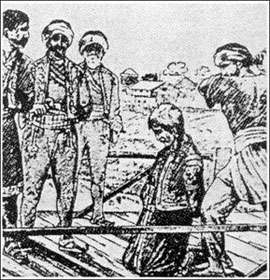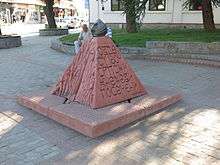Slaughter of the Knezes
| Slaughter of the Knezes | |
|---|---|
|
Tablet at Belgrade Military history museum | |
| Location | Sanjak of Smederevo (now Central Serbia) |
| Date | 23–29 January 1804 |
| Target | Notable Serbs |
Attack type | Assassinations and assaults |
| Deaths | 72 |
| Perpetrators | Dahije (renegade Janissaries) |
The Slaughter of the Knezes (Serbian: Сеча кнезова/Seča knezova) refers to the organized assassinations and assaults of notable Serbs in the Sanjak of Smederevo in January 1804 by the Dahije, the renegade Janissary officers who ruled the Sanjak independently and in defiance to the sultan after taking it over in 1801. Fearing that the sultan would make use of the Serbs to oust them, they decided to execute leading Serbs throughout the sanjak. A total of 72 notable Serbs were assassinated, and their heads were put on public display. Notable victims were Aleksa Nenadović and Ilija Birčanin. The event triggered the First Serbian Uprising, aimed at putting an end to the centuries of Ottoman occupation.
Background
In 1788, Koča's frontier rebellion saw most of Šumadija occupied by the Serbian Free Corps, a volunteer militia loyal to the Austrians. Belgrade was besieged by Austrian forces in late 1789, occupied until 1791 when it was handed back to the Ottomans after concluding peace. In 1793 and 1796 Sultan Selim III proclaimed firmans (decrees) which gave more rights to Serbs. Among other things, taxes were to be collected by the obor-knez; freedom of trade and religion were granted and there was peace. Each village had a knez and 10 villages had an obor-knez.[1] Selim III also decreed that some unpopular Janissaries were to leave the Sanjak of Smederevo (also known as the "Belgrade Pashaluk") as he saw them as a threat to the central authority of Hadži Mustafa Pasha, the governor. Many of those Janissaries were employed by or found refuge with Osman Pazvantoğlu, a renegade opponent of Selim III in the Sanjak of Vidin. Fearing the dissolution of the Janissary command in the Sanjak of Smederevo, Osman Pazvantoğlu launched a series of raids against Serbians without the permission of Selim III, causing much volatility and fear in the region.[2] Pazvantoğlu was defeated in 1793 by a Serbian contingent at the Battle of Kolari.[3] In the summer of 1797 the sultan appointed Mustafa Pasha on position of beglerbeg of Rumelia Eyalet and he left Serbia for Plovdiv to fight against Pazvantoğlu and his rebels.[4] During the absence of Mustafa Pasha, the forces of Pazvantoğlu captured Požarevac and besieged the Belgrade fortress.[5] Mustafa Pasha planned to raise taxes in order to pay for the operations against the Janissary rebels, however, he was persuaded by the Serbian knezes to rely on them on mustering a force of the local population.[6] The Serbians were able to collect 10,000 fighters.[1] At the end of November 1797 obor-knezes Aleksa Nenadović, Ilija Birčanin and Nikola Grbović from Valjevo brought their forces to Belgrade and forced the besieging Janissary forces to retreat to Smederevo.[7][8] By 1799 the Janissary corps had returned, as they were pardoned by the Sultan's decree, and they immediately suspended the Serbian autonomy and drastically increased taxes, enforcing martial law in Serbia. On 15 December 1801 Mustafa Pasha was assassinated by Kuchuk Alija, one of four Dahije (the renegade Jannissary leaders in the Sanjak of Smederevo).[9] The Dahije henceforth ruled the Sanjak independently of, and in defiance to the sultan.[10]

The tyranny endured by the Serbs caused them to send a petition to the Sultan, which the Dahije learnt of.[11] According to Leopold von Ranke, the Dahije started to fear that the Sultan would make use of the Serbs to oust them; to forestall this they decided to execute leading Serbs throughout the sanjak.[10] In fact, the Dahije learnt of a conspiracy between the Serbians and Mustafa Pasha's associates (who wanted revenge) to rise against the Dahije, forged in 1803.[12] A letter to an Austrian officer inviting for conflict, most likely written by Hadži-Ruvim, was intercepted.[13]
History

The Dahije sent secret orders to their muteselims to kill each of their knez on the given day.[14] It seems that Mehmed-aga Fočić was tasked with overseeing the operation.[15] The victims were obor-knezes, knezes, buljubašas and other chosen people.[16] Most of the knezes were killed on 23 January, while Hadži-Ruvim was killed on 29 January.[17] By 25 January, the Dahije decided that notable Serbs were to be beaten, so that what was left would become real "rayah, to serve the Turks well".[16] Other Ottoman lords then began to attack chosen notable people in their districts.[16] Karađorđe survived attempts.[18] According to contemporary accounts, heads were put on public display at the Valjevo town square to serve as an example to those who might plot against the rule of the Dahije.[10] By 4 February, 72 decapitated heads were brought to Belgrade.[15]
List of victims

- obor-knez Aleksa Nenadović of Tamnava-Posava in the Valjevo nahija. 23 January.
- obor-knez Ilija Birčanin of Podgor in the Valjevo nahija. 23 January.
- knez Stanoje Mihajlović of Kolubara in the Belgrade nahija. 24–25 January.
- knez Teofan of Orašje in the Smederevo nahija.
- knez Petar of Resava in the Jagodina nahija.
- knez Marko Čarapić of Beli Potok in the Belgrade nahija.
- knez Stevan Andrejević Palalija of Begaljica in the Grocka nahija.[19]
- knez Jovan
- buljukbaša Mata of Lipovac in the Kragujevac nahija.
- buljukbaša Gavrilo Buđevac.
- kmet Janko Gagić of Boleč in the Grocka nahija.
- hegumen Hadži-Ðera of the Monastery Moravica.
- archimandrite Hadži-Ruvim of the Monastery Bogovadja.
- obor-knez Nikola Grbović of Mratišića
- knez Tavnavski of Ljutica
- knez Mačvanski of Bogatić
- knez Pocerski of Metković
- Hadži-Melentij Stevanović
See also
| Wikimedia Commons has media related to Slaughter of the Knezes. |
References
- 1 2 Pantelić 1949, p. 123.
- ↑ von Ranke 1847.
- ↑ Roger Viers Paxton (1968). Russia and the First Serbian Revolution: A Diplomatic and Political Study. The Initial Phase, 1804-1807. - (Stanford) 1968. VII, 255 S. 8°. Department of History, Stanford University. p. 13.
- ↑ Ćorović 1997
U leto 1797. sultan ga je imenovao za rumeliskog begler-bega i Mustafa je otišao u Plovdiv, da rukovodi akcijom protiv buntovnika iz Vidina i u Rumeliji.
- ↑ Ćorović 1997
Za vreme njegova otsutstva vidinski gospodar sa janičarima naredio je brz napad i potukao je srpsku i pašinu vojsku kod Požarevca, pa je prodro sve do Beograda i zauzeo samu varoš.
- ↑ Pantelić 1949, p. 122.
- ↑ Filipović, Stanoje R. (1982). Podrinsko-kolubarski region. RNIRO "Glas Podrinja". p. 60.
Ваљевски кнезови Алекса Ненадовић, Илија Бирчанин и Никола Грбовић довели су своју војску у Београд и учествовали у оштрој борби са јаничарима који су се побеђени повукли.
- ↑ Ćorović 1997
Pred sam Božić stigoše u pomoć valjevski Srbi i sa njihovom pomoću turska gradska posada odbi napadače i očisti grad. Ilija Birčanin gonio je "Vidinlije" sve do Smedereva.
- ↑ Ćorović 2001, "janjičari ga 15. decembra 1801. ubiše u beogradskom gradu. Potom uzeše vlast u svoje ruke, spremni da je brane svima sredstvima. Kao glavne njihove vođe istakoše se četiri dahije: Kučuk Alija, pašin ubica, Aganlija, Mula Jusuf i Mehmed-aga Fočić.".
- 1 2 3 von Ranke 1847, pp. 119–120.
- ↑ Morison 2012, p. xvii.
- ↑ Novaković 1904, pp. 43–48.
- ↑ Novaković 1904, pp. 43, 46.
- ↑ Novaković 1904, p. 53.
- 1 2 Novaković 1904, p. 54.
- 1 2 3 Novaković 1904, p. 55.
- ↑ Novaković 1904, pp. 53–55.
- ↑ Novaković 1904, p. 57.
- ↑ Jovan Janićijević (1998). The cultural treasury of Serbia. Translated by Alice Copple-Tošić (2 ed.). IDEA. p. 270.
Sources
- Gavrilović, Andra (1904). "Crte iz istorije oslobođenja Srbije". pp. 7–42. (Public Domain)
- Morison, W. A. (2012) [1942]. The Revolt of the Serbs Against the Turks: (1804-1813). Cambridge University Press. ISBN 978-1-107-67606-0.
- Novaković, Stojan (1904). Ustanak na dahije 1804. (Public Domain)
- Pantelić, Dušan (1949). Prilike u Beogradskom Pašaluku pred prvi Srpski ustanak 1794–1804. SANU.
- von Ranke, Leopold (1847). History of Servia, and the Servian Revolution. J. Murray.
- Višnjić, Filip (1815). Početak bune protiv dahija.